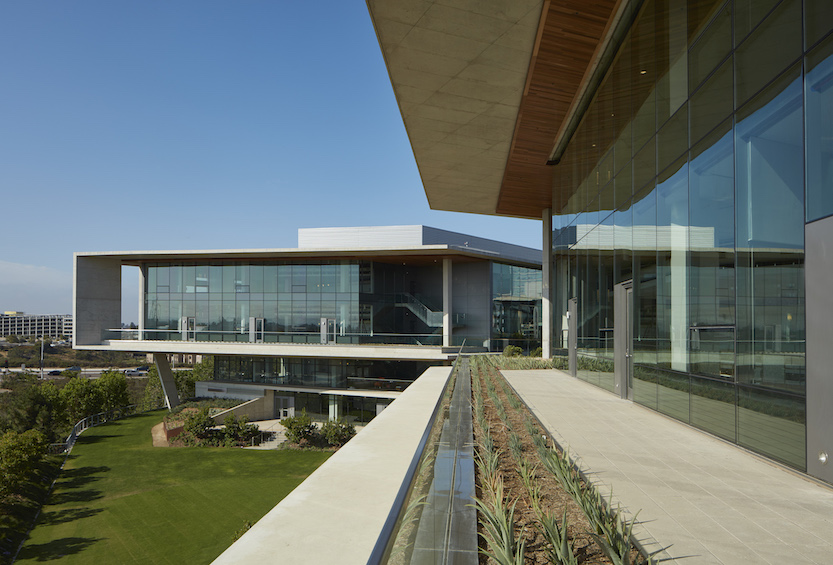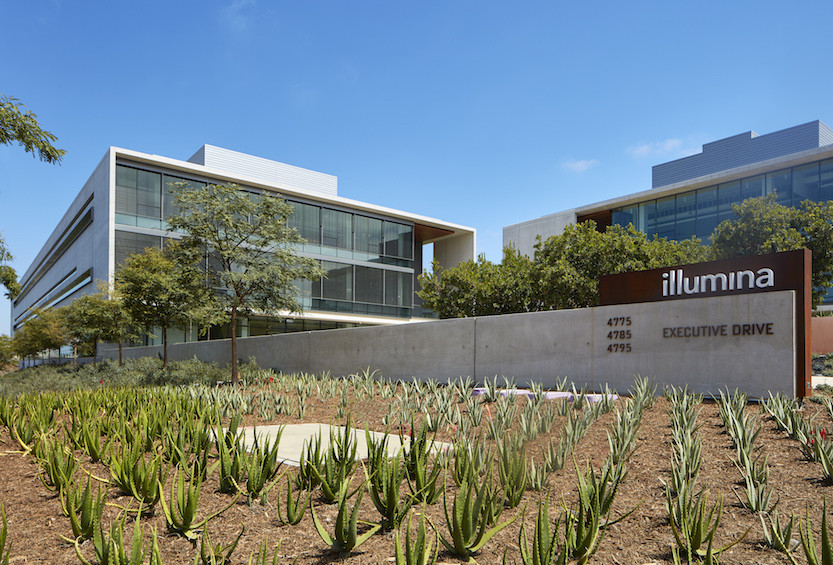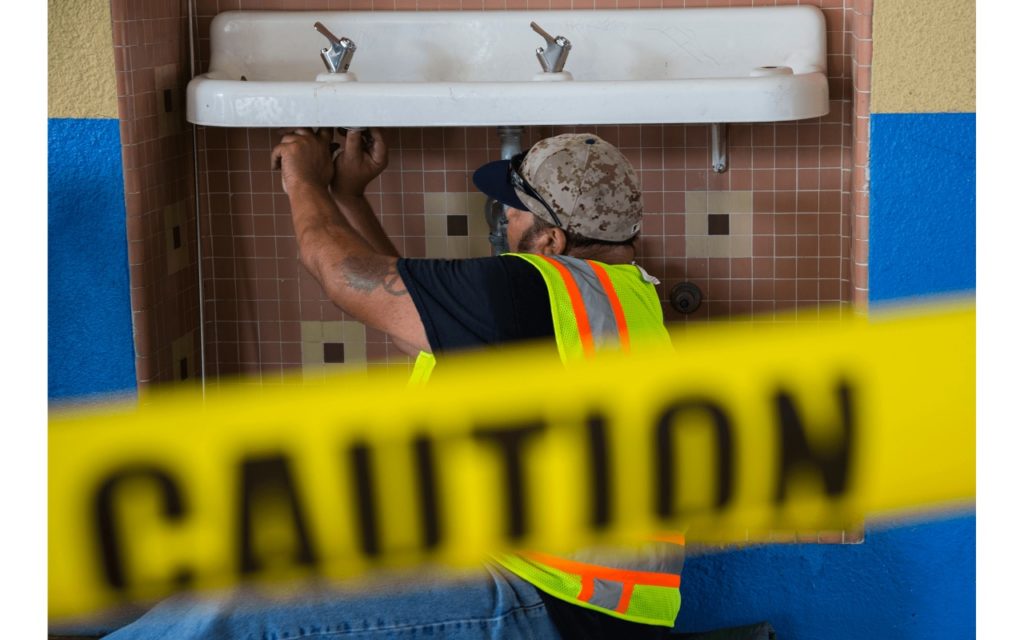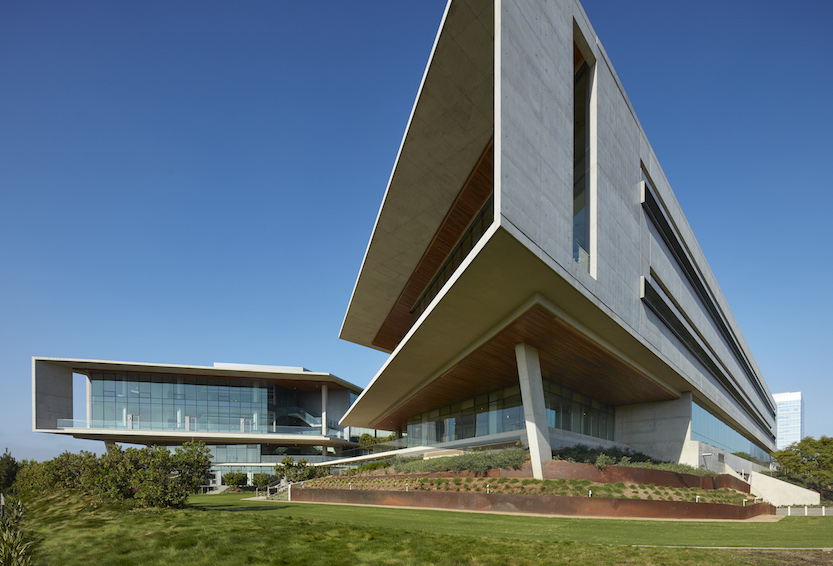Daily Business Report-Aug. 21, 2017
Illumina makes its home in the new BioMed Realty i3 campus. (Photos courtesy of Perkins+Will)
BioMed Realty i3 Campus Now Home
to Genomics Research Firm Illumina
A set of three trapezoidal, all-white concrete buildings off Interstate 805 and La Jolla Village Drive make up the new BioMed Realty i3 campus, now the home of leading genomics research and life sciences company Illumina.
Along with an outdoor courtyard, landscaped gathering spaces, and underground parking, the architecturally striking buildings offer employees an open, interconnected work-play experience.
Architecture firm Perkins+Will was responsible for the design.

“The campus turns the stereotypical concept of a suburban research park right on its head, and makes it infinitely better,” said Ryan Bussard, principal at Perkins+Will. “Instead of a trove of uninviting office buildings surrounding a sea of asphalt parking lots, the i3 campus empowers people to connect, engage, collaborate, innovate, and — perhaps most important — be inspired.”

The three buildings are situated such that each creates an “edge” of a campus “triangle,” at whose center is a 33,500-square‐foot outdoor courtyard featuring a performance stage, a bocce ball court, an herb garden, a fitness area, a restaurant and a café. Additionally, parking is obscured from view below ground, allowing for employees to enjoy a beautifully landscaped outdoor area for sports and leisure activities.

“Together with Perkins+Will, we breathed new life into an undervalued site, and delivered fresh, creative and eco-friendly thinking to attract a world-class tenant and exemplifies our goal of building science around a park, not a parking lot,” said Kevin Tremblay, senior director of leasing and San Diego market lead with BioMed Realty, a Blackstone company.
Architecturally, the campus’s three buildings join a family of well-‐known scientific institutions —t he Salk Institute and the J. Craig Venter institute —with all-white architectural concrete skin. Dramatic cantilevers create iconic views of the campus from the outside while internally framing the upper level terraces and outdoor staircases.
The project’s interior design was inspired by Illumina’s “work anywhere” culture, enabling staff to work wherever they feel most comfortable at any time of day. The campus is 100 percent wireless and provides a variety of work areas to accommodate different work styles and preferences.
Collaborative areas, such as lounges, break rooms, and conference spaces, are connected directly to outdoor terraces and bookend the research and office areas.
The project team includes:
Design Architect and Interior Architect: Perkins+Will
General Contractor: McCarthy
Mechanical, Electrical, Lighting, Plumbing Engineering: EXP
Structural Engineering: Hope-Amundson
Acoustical Design: Mei Wu Acoustics
Landscape Architect: The Office of James Burnett
Civil: Latitude 33
Kitchen Consultant: Orness Design Group Inc.
The i3 campus is located in University Town Centre at 4775, 4785 and 4795 Executive Drive.
______________________

Drinking Lead — Why California May
Force All Schools to Test Their Water
By Elizabeth Aguilera | CALmatters
When a therapy dog refused to drink at a San Diego grade school, it was the first clue that something was wrong with the water.
Tests revealed why the pup turned up its nose — the presence of polyvinyl chloride, the polymer in PVC pipes that degrade over time. But further analysis found something else that had gone undetected by the dog, the teachers and students of the San Diego Cooperative Charter School, and the school district: elevated levels of lead.
Nor is this an isolated situation. Tests have turned up harmful levels of lead in water fountains and taps at other schools in San Diego and Los Angeles, where the district long ago decided to identify, flush and fix contaminated fountains. And in the wake of the much-publicized toxic lead contamination of water in Flint, Mich., a Reuters report revealed dozens of California neighborhoods in which tested children showed elevated levels of lead — a neurotoxin that causes developmental disorders and brain damage. No amount of lead in humans is considered safe.
The news has left California legislators anxious that children exposed to lead may go undiagnosed under the status quo. Doctors here typically refer children for lead testing only if the family says it lives in a home more than 40 years old, with peeling paint, and are on low-income assistance programs. And although public schools can voluntarily test their water for lead—free under a new California Water Boards program — they are under no legal requirement to do so.
That’s not enough for the sponsors of two bills the Legislature will decide on in the next month:
AB 1316, authored by Bill Quirk, D-Hayward, would have the state Public Health Department consider urging doctors to ask families more questions as they assess the risk of lead exposure. That could include inquiring about whether the family lives near a major highway or a former lead or steel smelter, and whether a child might be exposed by spending time in another home or building. Once those inquiries result in children being tested, the bill would require the state health department to report the data more promptly and thoroughly.
AB 746 , authored by Lorena Gonzalez Fletcher, D-San Diego, would require all school districts to test their water for lead and fix or cap any contaminated water source.
How widespread is the problem? The national Centers for Disease Control found that 5 percent of tested children in Flint had elevated lead levels. In California, the state Department of Public Health has found that 2 percent of tested children have elevated levels.
But there are hot spots of trouble. In Alameda County, eight zip codes showed rates higher than or equal to Flint. Zip codes within Los Angeles, Monterey and Humboldt counties also showed higher rates of childhood lead exposure. In one Fresno zip code, nearly 14 percent of the children tested had elevated levels of lead.
The state Public Health Department cautions that the numbers are not an accurate representation of all children because only those whom health providers believe may be at risk are tested.
But its data is also old. The department says those percentages are based on data from 2012, the most recent year the state department says it has—despite the collection of 700,000 blood lead level test results sent in each year from labs statewide.
CALmatters is a nonprofit, nonpartisan media venture explaining California’s policies and politics.
______________________

The unemployment rate in San Diego County moved to 4.7 percent in July, up from a revised 4.3 percent in June, and below the year-ago estimate of 5.1 percent, the state Employment Development Department reported. California’s jobless rate was 5.4 percent and the nation’s was 4.6 percent for the same period.
Between June and July, total nonfarm employment declined from 1,449,200 to 1,441,300, a loss of 7,900 jobs. Government recorded the largest employment decline, down 11,500 jobs.
Between July 2016 and July 2017, nonfarm employment gained 20,400 jobs, or 1.4 percent. Government posted the greatest year-over gain, adding 9,100 jobs.
______________________
Grossmont Healthcare District Awards
$89,000 to Grossmont College Division
The Grossmont Healthcare District has awarded a $89,440 grant to Grossmont College’s Allied Health Division to be applied toward the purchase of three pieces of equipment that will assist in the training of cardiovascular, respiratory and orthopedic technology students.
The grant will help purchase a SurgiStat electrosurgical generator made by Dublin, Ireland-based Medtronic that will help cardiovascular students learn about electrocautery procedures used during a variety of interventional cardiac diagnostic procedures. District funds also will help orthopedic students practice casting and splinting using a new cast cutter and cast dust vacuum manufactured by Stryker Corp. of Kalamazoo, Mich.
______________________
Personnel Announcements
Grant Thornton Admits Adam Steinmetz as Partner

Grant Thornton LLP admitted Adam Steinmetz as tax partner in the firm’s San Diego office. Across the firm, Grant Thornton admitted 39 new partners and principals, and promoted 28 professionals to managing director.
Steinmetz joined the firm in 2007 and has more than 11 years of experience consulting on a wide variety of tax matters. He specializes in corporate consulting, federal income tax provisions, audit support, and mergers and acquisitions support.
He has served companies in San Diego for seven years, and works with a variety of enterprises including emerging growth companies, pre-initial public offering companies, complex private companies and large public companies. Prior to being admitted as partner, Steinmetz served as a senior manager.
Steinmetz received his master’s degree from California State University and his bachelor’s degree from California Polytechnic University.


